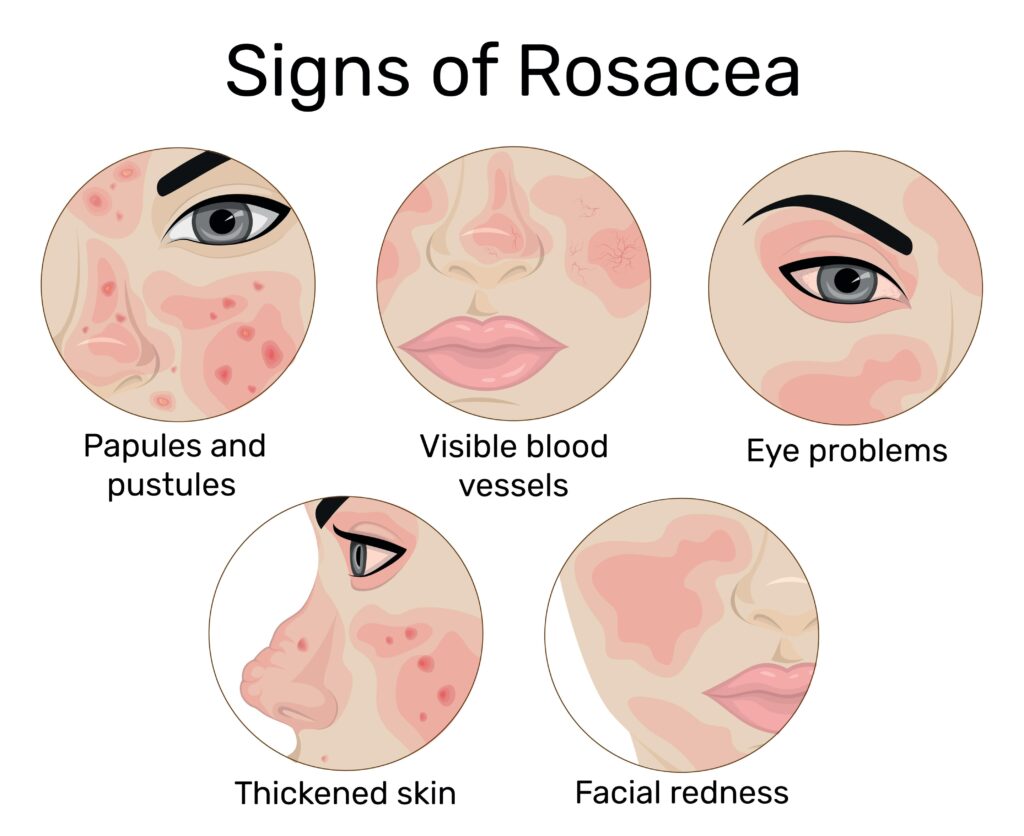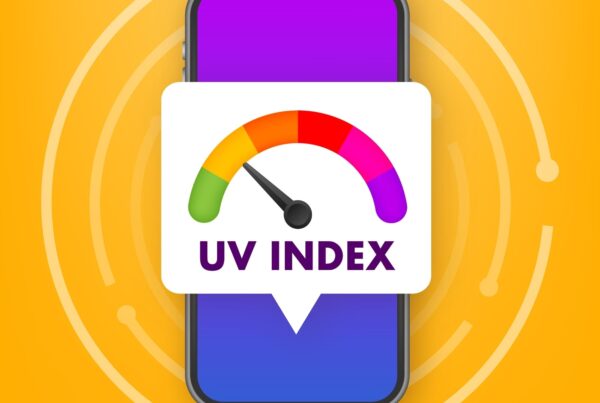Rosacea is a chronic skin condition that usually affects the face. Like other skin conditions, rosacea involves flare-ups and periods of remission.
While rosacea can affect people of any age, it’s most common in people older than 30. Usually, the first sign of rosacea is the flushing of the face, nose, cheeks, chin, or forehead.
If you don’t treat rosacea, inflammatory bumps and pimples can develop. Additionally, the nose may become swollen and bumpy. About 50% of people with rosacea also notice irritated, watery, or bloodshot eyes.
Fortunately, you don’t have to live with painful or embarrassing rosacea side effects forever. In this blog, we’ll discuss the causes, symptoms, and treatments for rosacea so you can decide what’s right for you.
First Things First: What Causes Rosacea?
Currently, nobody knows what causes rosacea.
Some researchers believe it’s the product of an overactive immune system, while others believe it has to do with heredity or environmental factors.
What scientists do know is that rosacea is not contagious, and it’s not caused by poor hygiene.
If you have rosacea, you may notice that the following can cause or worsen flare-ups:
- Spicy foods or hot drinks.
- Alcoholic beverages.
- Extremes in temperature or weather.
- Sun or wind exposure.
- Periods of intense stress or emotion.
- Exercise.
- Medications that dilate the blood vessels, including but not limited to certain blood pressure medications.
- Certain hair, skin, or cosmetic products.
6 Common Signs and Symptoms of Rosacea

Common symptoms of rosacea include the following:
- Blushing or flushing of the face
Rosacea causes persistent flushing and blushing in the central portion of the face. This discoloration may be difficult to see on darker skin but tends to be very obvious on fair skin.
- Visible veins
Rosacea causes the small blood vessels in and around the nose and cheeks to break and become visible.
- Swollen bumps
Rosacea can cause people to develop pimples on their faces that may look like acne. The pimples may be sore to the touch and often contain pus.
- Burning sensations
Many people who have rosacea report that their skin feels hot and tender and that they often experience a burning sensation.
- Eye problems
In some people, rosacea can cause the eyelids to become dry, irritated, and swollen. This condition, known as ocular rosacea, usually precedes symptoms on the rest of the face.
- Enlarged noses
Over time, rosacea thickens the skin on and around the nose. This causes the nose to appear larger and bulbous (a condition known as rhinophyma). This condition is more common in men than women.
The 4 Different Types Of Rosacea
Now that you understand the signs and symptoms of rosacea let’s discuss the different types of the condition.
As it stands now, there are four distinct types of rosacea, although many people experience symptoms of more than one type.
The types of rosacea include the following:
- Erythematotelangiectatic rosacea. Erythematotelangiectatic rosacea is characterized by persistent and problematic redness on the face. People with this type of rosacea commonly experience spider veins and other facial symptoms that flare up and disappear. Left untreated, erythematotelangiectatic rosacea will cause redness that becomes more persistent, covers a larger skin area, or becomes permanent.
- Papulopustular rosacea. Papulopustular rosacea causes “whitehead” pustules that resemble pimples. These pus-filled blemishes are red and swollen and typically appear on the chin, cheeks, and forehead. This condition may be misdiagnosed as acne and can be painful and embarrassing to endure.
- Phymatous rosacea. Phymatous rosacea causes the skin in affected areas to scar and thicken, creating swollen, bumpy, or discolored patches. This type of rosacea often affects the nose, creating the bulbous nose many people associate with the condition.
- Ocular rosacea. Ocular rosacea causes the eyes to look bloodshot and watery and to feel irritated, sensitive, and painful.
How to Manage Rosacea Flare-Ups
Because rosacea flare-ups can be troubling and painful, managing them effectively is critically important. Here are some tips to manage and prevent flare-ups:
Identify and avoid triggers
Everyone’s rosacea triggers are different. By far, the best way to manage your flare-ups is to identify and avoid your triggers whenever possible.
Use sun protection
Even minimal sunlight exposure on rosacea-prone skin can cause painful, uncontrollable flushing and redness.
With this in mind, follow these tips to protect your skin from the sun:
- Apply a gentle, broad-spectrum sunscreen with an SPF of at least 30. Use the sunscreen daily, and look for a formula that contains zinc oxide or titanium dioxide, as these ingredients are least likely to irritate rosacea-prone skin.
- Wear a wide-brimmed hat if you’re going to be outdoors during the day.
- Stay out of the midday sun and go inside during the heat of the day.
Manage stress
If stress is one of your rosacea triggers, find ways to manage stress so it doesn’t cause flare-ups.
Here are a few tips that may work:
- Practice stress-relieving activities like meditation, walking, or breaking exercises.
- Find space to do something you enjoy every day.
- During periods of acute stress, practice deep breathing to re-regulate your physiology.
Avoid overheating
Heat can be a major rosacea trigger for some people. To keep your skin cool and comfortable, follow these tips to avoid overheating:
- Instead of hot showers and baths, keep the water lukewarm.
- Dress in layers so you can quickly remove layers and cool down if you feel overheated.
- When you feel too hot, drape a cold, wet cloth around your neck.
- Stay far away from heat sources like fireplaces and heaters so you don’t accidentally irritate your skin.
- Avoid hot beverages, opting for iced coffee or tea instead. Alternatively, allow hot beverages to cool slightly so they’re warm or lukewarm before you consume them.
Find ways to manage the emotional impact of rosacea

According to a recent study, 90% of people with rosacea reported that rosacea’s effect on their personal appearance lowered their self-confidence and self-esteem.
With these figures in mind, it’s obvious that finding ways to cope with the emotional impact of rosacea is key.
One of the best ways to do this is to find effective treatments for your rosacea. Today, there are many minimally invasive and highly effective treatments on the market that address the symptoms of rosacea and help people feel happier and more confident.
In addition to treating the condition, be sure to take care of your mental health. Join rosacea community support groups, talk to a therapist, and take opportunities to encourage open conversations about rosacea with your friends, family members, and co-workers about the condition.
Rosacea Treatment Options and Management Techniques
There is no known cause of rosacea and no permanent cure, but there are effective treatment plans to manage side effects and symptoms.
They include the following:
- Oral and topical medications. Dermatologists may prescribe oral or topical medications to treat the signs and symptoms of rosacea and manage discomfort.
- Phototherapy. For some people with rosacea, laser treatment can help restore the health of blood vessels and correct skin discoloration. Our office offers the Cutera Excel V laser to effectively treat Rosacea.
- Skin care regimens. Proper skin care is an effective way to treat rosacea. Dermatologists recommend a gentle skin-care routine that includes mild and non-abrasive cleansers, lukewarm water for showers and baths, and gently patting (rather than rubbing) the skin dry. Patients should also use non-irritating skin care products, avoid the sun, use SPF, and avoid any skincare products that cause stinging, burning, or redness.
When to Seek Professional Help

If you think you may have rosacea, visit your dermatologist immediately.
Because rosacea can get worse or become permanent without treatment, it’s essential to visit a skincare professional.
Additionally, regular follow-ups and adjustments to your treatment may be needed to help you enjoy healthy, happy skin and as few rosacea symptoms as possible.
Final Thoughts
Rosacea is a very common skin condition, and while there is no cure, there are many effective management techniques.
Simple things, like using gentle skin care products, applying SPF daily, avoiding overheating, and seeing your dermatologist can all help minimize rosacea s symptoms and flare-ups.
If you’ve been diagnosed with rosacea or you think you may have this or another skin condition, make an appointment with a dermatologist right away.
The team here at Dermatology Associates can help you manage and treat your condition and live a happy, healthy, confident life in your best skin yet.
Contact us today to learn more or schedule your initial consultation.





